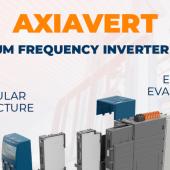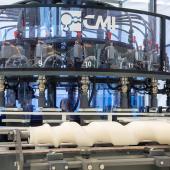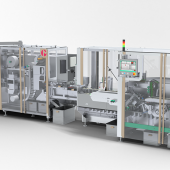Automation & the packaging sector
Some of the most exciting new developments and trends to emerge during the fairs, which illustrate the value and necessity of an ever closer relationship between the world of manufacturing and that of IT. In this second article, our correspondent at SPS Italia and Ipack-Ima shines a light on servo drives, AGCs and robots. Maurizio Cacciamani
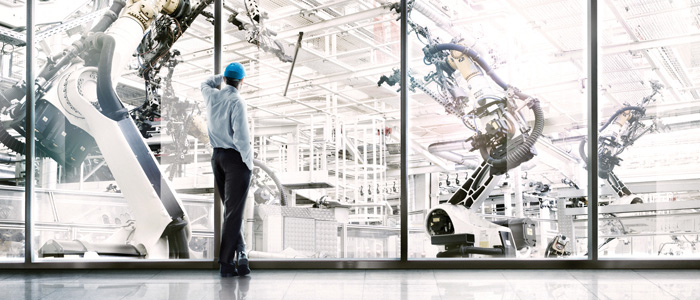
Before examining the technological trends that emerged at the two major fair events, let’s take a quick look at the economic performance of the Italian electrical engineering and electronics industry during the first half of 2018. This is of course a sector in which automation plays an essential role.
According to the survey conducted by ANIE, during the first half of the year, the 130 participating enterprises (with a combined turnover of 15 billion euro) feel positively about the market trend. In particular, 58% of concerns saw their turnover increase compared to the same period the previous year, while 63% saw an increase in orders, with similar performance among large, medium and small enterprises. 46% saw their turnover from exports increase over that of the first half of 2017.
ISTAT data on orders in the ANIE sectors during the first four months of 2018 also shows double-digit growth (+13.9%), both domestic and foreign, while turnover went up by 5.4%.
Looking at employment, 86% of survey respondents reported no reduction to their total workforce. However, there remain too few technicians and engineers to meet domestic demand for them.
Trends
● The observations reported in the previous article (ItaliaImballaggio, July/August 2018, page ) are also valid for servo drive systems/motion control. Communication has become a minimum requirement. All components need to be capable of communicating with every other component both above and below (MEM, etc.). Every operator is either in the process of implementing safety functions in their servo drive systems, or has already done so. Increasingly, the same can also be said of vision systems.
Systems are becoming more compact, and this also goes for motor + servo solutions, which, in such a way, can be installed onboard the machine, even with limited available space (in this case careful attention is owed to the problem of heat dispersal).
Artificial intelligence is also beginning to make appearances in motion systems, helping to automatically detect system issues and assisting in their resolution by logging collected data.
● Automated guided carts (AGC), unlike automated guided vehicles (AGV), require no guide rail installed on the factory floor in order to function, but can move freely along a learned pathway, avoiding any obstacles or people in its way thanks to onboard sensors. These vehicles are beginning to spread in the market thanks to the flexibility they offer (e.g. when the plant changes its layout and the AGC must be taught a new pathway). The installation of smart sensors on board also makes it possible to gather data for analysis later. AGCs are suitable for handling products or components in transit between different areas within the factory and logistics. Specially developed software enables fleet management.
● Cobots are the hot new thing, but they also appear to be the market’s top seller (the most recent available market data is from 2016)! Their commercial success is illustrated by the fact that Omron, which had none in its catalog, just before SPS announced an agreement with Taiwanese firm Techman Robot to market the latter’s TM series, while Yaskawa took the opportunity at the fair to present a cobot of its own.
Flexible, lightweight and maintenance-free (since not required for safety), easy to install and program, they are spreading also thanks to advantageous costs and the fact that they enable real-time data monitoring, performance measurements and rapid response. Most importantly, they have made robotics accessible and suitable for every type of business, no matter the size or turnover.
However, this is no reason to leave other robot types by the wayside. As will be elaborated on further on, there are many novelties. A final note: robot/cobots are being installed on AGCs/AGVs to enhance the latter’s flexibility. Such solutions are proliferating, as we can see from the many demos on display at Ipack-Ima.
Overview of servo systems, AGCs and robots
SERVO DRIVES
Servo drives with integrated cc-link IE network or STO. The entry level servo range of MR-JE in SSCNET III/H by Mitsubishi Electric is now also available in the MR-JE-BF range, featuring integrated safety function and separate wiring for the power and control circuits, or the MR-JE-C, featuring an integrated CC-Link IE Field Basic network.
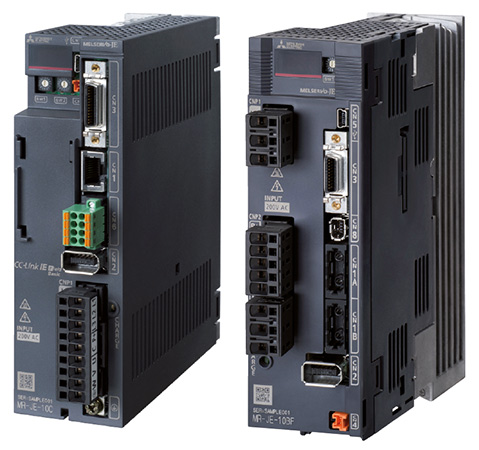
MR-JE-BF integrates Safe Torque Off (STO) as a standard feature. The MR-J3-D05 safety module enables it to also offer Safe Stop 1 (SS) as a standard feature. The control circuit power source, separate from that for the drive, keeps the network communication active even when the drive is powered down. In such a way, MR-JE-BF enables building cost-effective solutions with the utmost safety, with connectivity to the Simple Motion Modules of the various Mitsubishi iQ automation platforms, via SSCNET III/H fiber optic motion bus communication, which is completely noise-immune.
These new servos are suitable for applications requiring electronic cam functions, fly cutting, synchronization, those used in complex applications or high speed precision packaging jobs like flow-packs.
The MR-JE-C range is characterized by its networking capabilities, integrating the CC-Link IE Field Basic network, the 100Mbps Industrial Ethernet Network for connecting one network to a variety of devices, from remote I/Os to inverters, HMIs etc. In such a way, the user is able to perform positioning operations using a single industrial Ethernet network. MR-JE-C enables performing positioning according to the CiA 402 Drive Profile, thanks to the inclusion of a profile within the master.
MR-JE-C can also be connected to a Modbus/TCP network, with pulse train or analog voltage command.
The system is recommended for simple positioning for packaging, food, material handling or in applications requiring control of multiple axes independently and with no particular synchronizations.
Both the new series are available with 200 V single phase or three-phase power, in 100 W to 3 kW formats. Both come standard with integrated vibration suppression and drive recorder functions. The latter continuously records the various sizes of the servo, “freezing” them in case of alarm, for simplified maintenance.
Toward a more intelligent industry
The new integrated AI controller of the well-known Sysmac Omron platform is equipped with adaptive intelligence and is installed near the place where the activity is performed, where it learns to distinguish between normal and anomalous functioning schemata for a specific machine. It is primarily installed wherever the user experiences the most serious production efficiency issues (bottlenecks). The processes make use of the information gathered from previous operations and adjustments already made to optimize the production process as a whole in a holistic manner. By enhancing quality and employing predictive maintenance to prevent machine stops, the AI controller makes it possible to significantly increase process efficiency by 50% (average). It is important to note that a gain of just a few percentage points can translate into remarkable increases in efficiency and significant cost reduction. The AI solution is currently being tested by a number of Omron pilot customers
Brushless mini-motors
Cyber dynamic line è la gamma di mini servomotori brushless realizzata dalla divisione cyber motor di wittenstein, specializzata nei sistemi di servoazionamento a tecnologia brushless trifase, che si caratterizzano per l’elevata densità di potenza e dinamica, peso ridotto.
La serie, con potenza tra 25 e 335 Watt, è disponibile in quattro taglie con diametro esterno da 17, 22, 32 e 40 mm ed è dotata di encoder assoluto con risoluzione 12 bit e interfaccia BISS C. Per la bassa inerzia rotorica sono servomotori ideali per forti accelerazioni, brevi spostamenti e frequenti cambi di velocità, come nelle applicazioni pick & place.
Altro punto di forza della linea è l’elevata costante di coppia, che permette di ridurre le correnti in gioco e quindi le sezioni dei cavi, risparmiando spazio, peso e costi. I motori sono, inoltre, dotati di cavo ibrido contenente potenza e segnale in un unico connettore. L’uscita cavo è posizionata sul lato posteriore, col vantaggio di non dover cambiare anche il motore in caso di sostituzione del cavo o viceversa.
Cyber dynamic line is a range of brushless mini-servomotors developed by the cyber motor division of wittenstein, a specialist in servo drive systems using three-phase brushless technology. The line is characterized by high power density and dynamics and low weight. With a power range of 25 to 335 Watts, the motors are available in four sizes (external diameters 17, 22, 32 and 40 mm) and equipped with an absolute encoder with 12 bit resolution and BISS C interface. Due to their low rotary inertia, they are suitable for steep accelerations, slight shifting and frequent speed changes, such as in pick & place applications.
Another strength of the line is a high torque constant, which makes it possible to reduce the currents at play and thus also wiring, saving space, weight and costs. The motors are also equipped with a hybrid power/signal cable with a single connector. The cable output is located on the back side so that the user doesn’t need to change the motor to replace the cable and vice-versa.
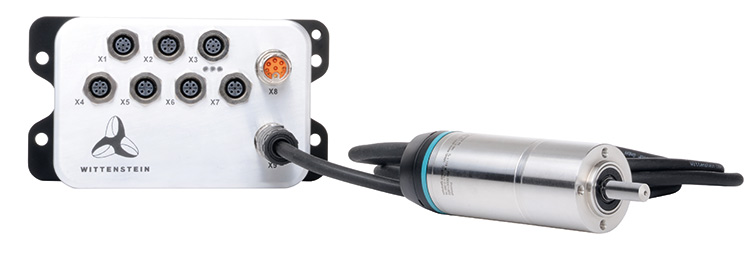
The 32 and 40 mm versions are also available with a miniaturized multiturn encoder with no batteries or gears. The technology of this absolute encoder is based on the Wiegand effect, by using an energy collection system to produce sufficient electrical impulses for the encoder. When the motor’s shaft rotates, the Wiegand sensor acts as an impulse generator, driven by the alteration to the magnetic field. In such a way, the rev counter works independently of any external power source.
Cyber dynamic line is also available in inox and hygienic design versions for anti-corrosive solutions and to guarantee high hygienic standards. The materials used and the design specially conceived to avoid deposits of bacteria or other organic contaminants make it possible to integrate them directly into the process and enables quick and safe cleaning even in sterile environments.
The inox version is IP66/IP67, while the hygienic design version, made of stainless steel, offers IP69K protection against strong water jets, including high temperature, high pressure steam systems and temporary immersion. It is suitable for sectors such as pharmaceuticals, food and packaging.
ULTRA-COMPACT AND SUPER-INTELLIGENT
Everest is the new servo drive by Ingenia, distributed in Italy by Servotecnica, that is ultra-compact, super-intelligent and powerful. Thanks to its very small dimensions (26x35x14 mm) and rugged design, it is suitable for any applications, for example in the connectors of cobots, installed on a vehicle without additional components or directly on servomotors.
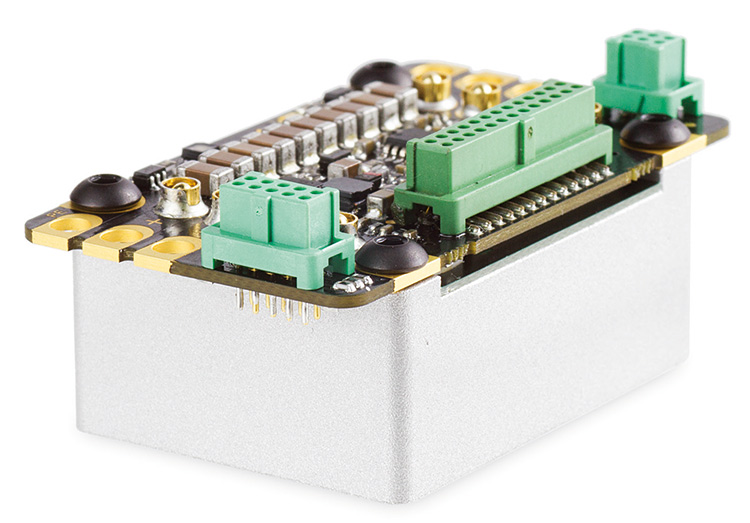
Everest incorporates a powerful MCU capable of processing advanced algorithms that can be developed regardless of whether they are dedicated to image stabilization or to implementing advanced humanoid robot control functions.
In the servomotor segment, the torque motors of the QTR series of the represented Tecnotion are worthy of note as they provide high torque density in low thickness geometries and a high internal diameter. Thanks to their low mass and compact dimensions, these torque motors are the ideal solution for compact and efficient applications. They best express their performance capabilities when driven by lngenia servo drives in applications such as collaborative, medical or humanoid robots.
The Tecnotion experience in the realization of the coils is directly reflected in the thermal characteristics of the QTR engines, resulting in high efficiency. Like all the ironcore engines produced by Tecnotion, the QTR series also features a low torque ripple that produces smooth motion and accurate positioning.
ROBOT
Handling cans, jars, doypacks...
For Ipack-Ima, Comau developed a new loadcell, integrated with a Racer-7-1.4 robot, dedicated for operations in a variety of industrial sectors (food, retail, cosmetics, etc.).
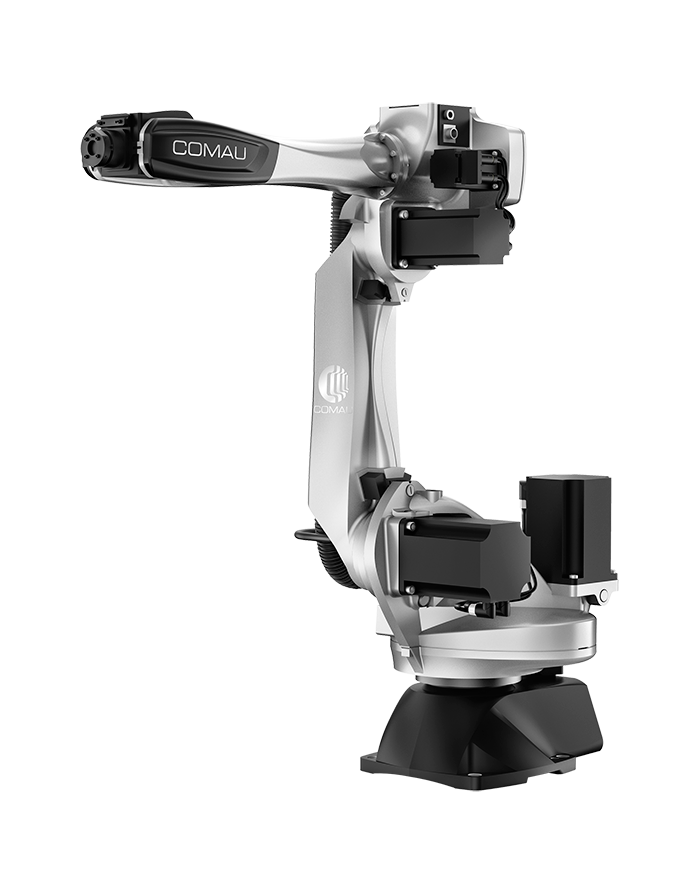
At the demo, the Comau robot handled with extreme flexibility a wide variety of products – for example, cans, jars, doypacks etc... – using different grippers according to the product type to pick. The gripper, automatically selected by the robot according to product type, can pick products of different type, shape (even more than one product at a time) and material. Furthermore, it enables picking fragile and delicate products, safeguarding both the surface of the packaging and its contents. The grippers operate on a variety of physical principles: for some cases a gripper with highly flexible silicon rubber fingers, or a “levitation” one, or a suction cup system.
In the real plant, the products reach the packing area on belts or shelves. The special grippers are able to pick different products with precision and to place them at a specific point after the multi-piece grip, thus achieving high productivity without stressing the machine. Depending on the products, the robot can be equipped with different types of grippers, using automatic gripper change.
A growing family of robots
Mitsubishi Electric expands its offer of Melfa FR robots and the new scara Melfa CH.
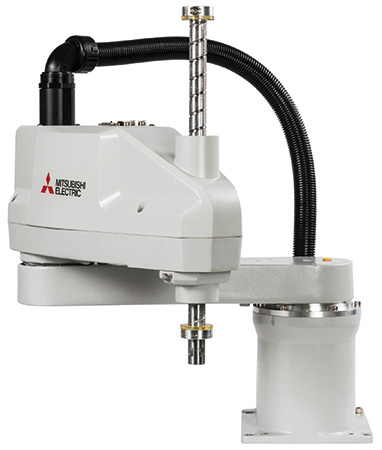
The new FR are advanced robots equipped with Smart Plus functionality, offering performance beyond expectations, and thanks to integration with the new iQ-R automation platform, they guarantee productivity, flexibility and advanced safety for collaborative applications.
The new scara RH-CH robots are ideal for pick & place, assembly and conveyor tracking applications for cost-effective solutions. These new models are feature a payload of 3 and 6 kg, with a respective maximum reach of 400 mm and 600-700 mm.
6-axis cobot
Featuring a 1200 mm reach and a 10 kg payload, Motoman HC10 by Yaskawa represents a new generation of robotics: capable, accessible, versatile and easy to use. Designed to work side-by-side with human operators within a single shared workspace, the cobot meets the regulatory requirements of the Machine Directive 2006/42/EC.
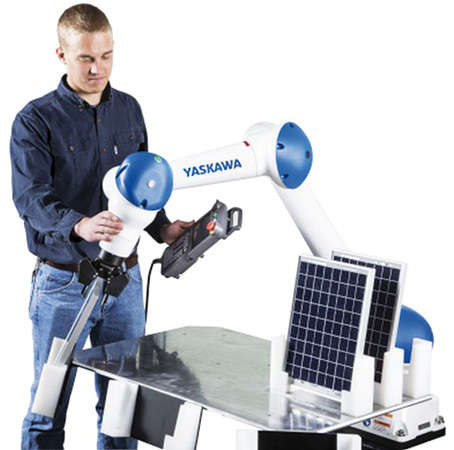
Thanks to the YRC1000 controller, featuring an FSU circuit board and Power and Force Limit technology (PFL), this cobot guarantees the performance level PLd Cat. 3 EN ISO 13849-1 with TUV Rhineland’s CE certification.
Operator safety is guaranteed by the PFL technology, which reacts immediately to external force, arresting the cobot in case of contact, leaving it available for reactivation.
The arm is designed with no sharp edges or other interfering contours or potential clamping zones. These characteristics enable the cobot to function without further protective measures, depending on the risk assessment and type of application, in compliance with ISO 13849-1 PLd Cat. 3 (industrial robot command safety functions), ISO 10218-1 (5.10.5 power and force limitation) and ISO TS 15066.
The cobot’s small size, its extreme versatility and the possibility of using it without safety cells make HC10’s installation highly flexible, allowing relocation between work spaces using a mobile platform, enabling an expanded field of application, beyond the scope of traditional ones.
The system’s ease of use is made possible by the INFORM programming language, which includes the EasyTeach function and enables easily managing the arm to define a path and waypoint to be followed by the robot in lead-through jogging or hand guiding mode. HC10 can also be programmed in the traditional way using Teach Pendant (weighing just 730 g), which shows the cobot’s positions on the display in 3D.
HC10 can be used as a hybrid robot, both as a cobot and as an industrial robot proper. This means that, where direct contact with the operator is unnecessary, the robot can function at full speed.
Scara robot with 200 picks/min
The four-axis FAST picker TP80 robots by Staubli are particularly adapted for packaging applications in various sectors (food, pharma and cosmetics). Extremely fast, they have been designed for handling of small components with a maximum weight of 1 kg. They enable ±0.05 mm repeatability thanks to a rigid frame. The reach is 800 mm, and the stroke is 100 mm (or optional 200 mm), and the speed is 200 picks/min. Furthermore, TP80 is specially designed not to interfere with the camera’s line of vision. The HE version is suitable for humid environments.

Elegant and easy to clean thanks to a completely closed frame and smooth surface, this scara robot is easy to integrate with the production line. The robot features reduced bulk and is easy to assemble using the wall-mounting unit, but it can also be installed on a mobile frame. The robots are UL, CE and KCS certified.
No more chains, belts, gears and rollers
It’s not news (having already been adopted by many leading OEMs for application in packaging, filling and pharmaceuticals), but the Rockwell Automation solution for in-line handling, Independent Cart Technology (iTrak & MagneMotion) continues to perfectly respond to the needs of business in terms of faster production changeover and greater flexibility.
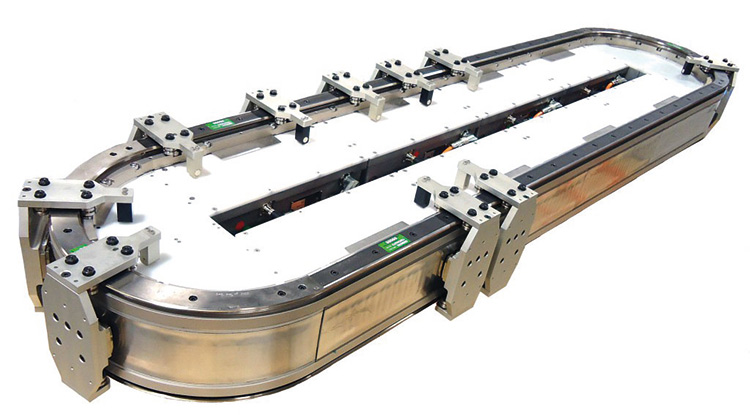
No more chains, belts, gears or rollers, as used in conventional systems with limited flexibility, heavy waste of energy and high maintenance costs, but a solution in which motion is managed by simple and effective software profiles and an independent, fast and flexible cart technology.
The advantages for OEMs and end users? Enhanced productivity, dramatically reduced maintenance and quick & easy format changeover thanks to standard communication protocols and software-configured profiles.
AUTOMATED VEHICLES
AGC complete with sensors for industry 4.0.
Among other novelties, at SPS SICK presented an Industry 4.0 demo, where visitors could witness a working example of the factory of tomorrow. The fascinating simulation manufactured objects personalized according to order specs in real time. An Automated Guided Cart (AGC) linked the production area to with the logistics operations, aided by a series of sensors that transmitted useful data to optimize its motions, while control and inspection systems checked the quality of the products and gathered information for efficient management of the smart factory.

Special AGC navigation sensors were created by the company’s AGC team, an interdisciplinary group specially assigned to develop dedicated solutions for this particular type of automated guided systems.
Unlike AGVs, AGCs can change direction in real time, making use of navigation data collected on the route. To do so, they can use three different solutions: optical line sensors (OLS), magnetic line sensors (MLS) and grid localization sensors (GLS) use the eponymous technologies to tell the AGC the right direction to follow. Whatever the navigation sensor decides, every cart is equipped with a laser safety scanner in order to avoid collisions with machinery or people and to provide information on the position of surrounding objects using a monitor and alarm signals, such as the TiM PL-b, a laser safety scanner featuring low bulk and costs, certified Performance Level b.
Mobile assistance systems
Maxolution by Sew Eurodrive, available in 9 versions, finds application in handling standardized goods for moving inside and outside the facility, autonomous transport of goods in packaging units, autonomous interaction with other systems for seamless exchange of goods, continuous logistical chain (data and material flows).

They can carry loads ranging from 150 to 1,500 kg, depending on the model, and they adapt to the height of the job. The vehicles autonomously map the environment using simultaneous localization and mapping (SLAM), enabling them to move freely. Laser safety scanners and optic distance scanners protect operators and vehicles. The transmission of optic data is LED-based.
Depending on the applications, the solution is powered either through collector bars or with the contactless Movitrans system, whose line cables can be installed either on the floor or along the guide rails. Also available is the intelligent Drive Power Solution, featuring an integrated power accumulator. Power peaks can be covered with Movitrans and the accumulator. With the CCU modules, the shuttles can be configured rather than programmed in the transport route for specific tasks.
Robot.











